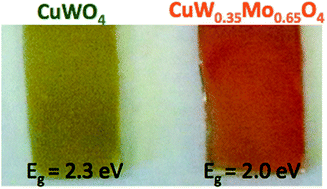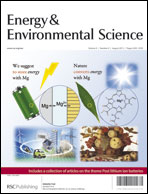Synthesis, photoelectrochemical properties, and first principles study of n-type CuW1−xMoxO4 electrodes showing enhanced visible light absorption†
Abstract
Molybdenum-rich solid solutions of CuWO4 and CuMoO4 (i.e., CuW1−xMoxO4, x > 0.4) having a wolframite structure were prepared as thin-film type electrodes using a new electrochemical route. The synthesis of Mo-rich CuW1−xMoxO4 was not previously achieved because the CuMoO4 phase that is isostructural to CuWO4 is not thermodynamically stable. The resulting solid solution, CuW0.35Mo0.65O4, exhibited a significantly reduced optical bandgap (Eg = 2.0 eV), compared to CuWO4 (Eg = 2.3 eV). Since both CuW0.35Mo0.65O4 and CuWO4 are n-type semiconductors, their photoelectrochemical properties were compared for possible use as photoanodes in


 Please wait while we load your content...
Please wait while we load your content...